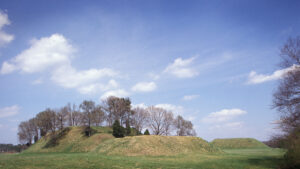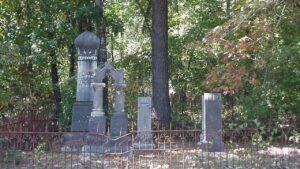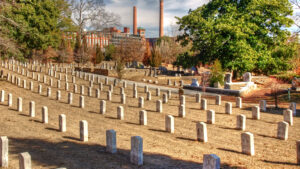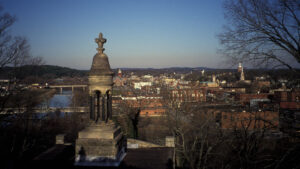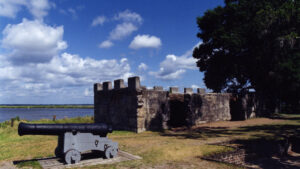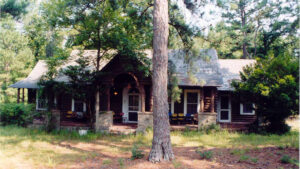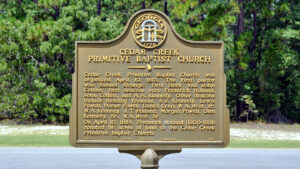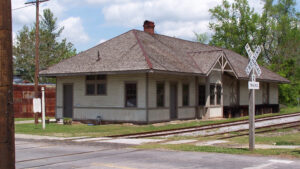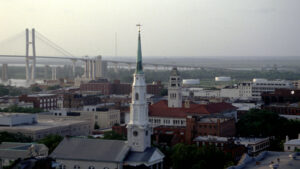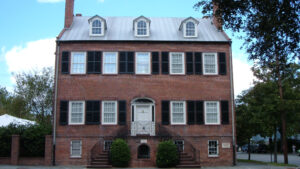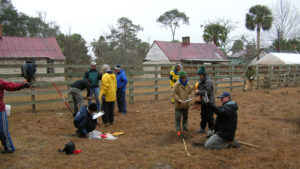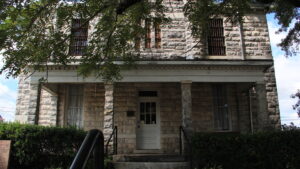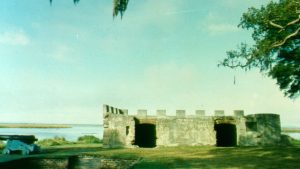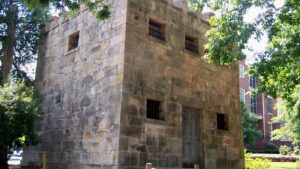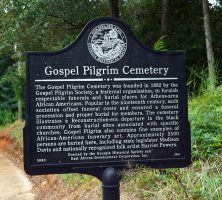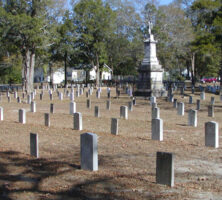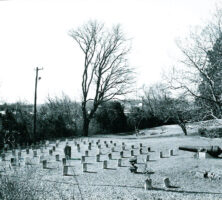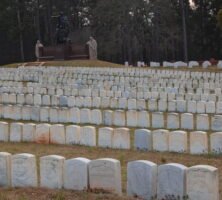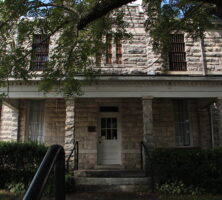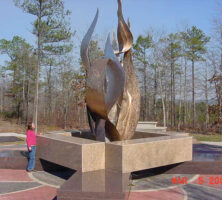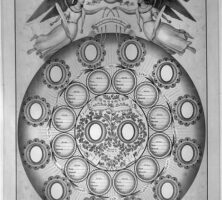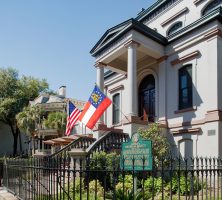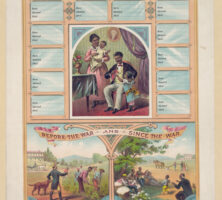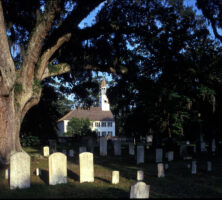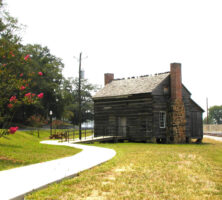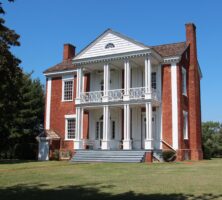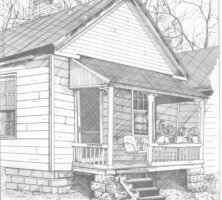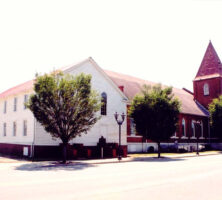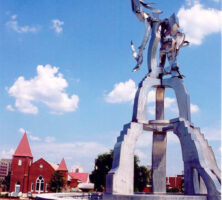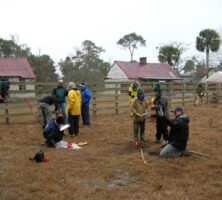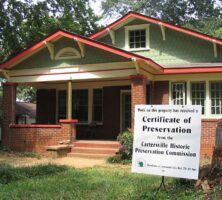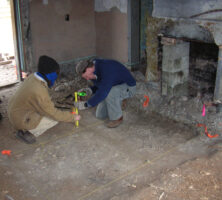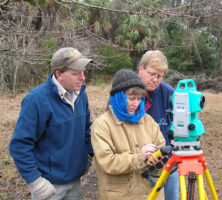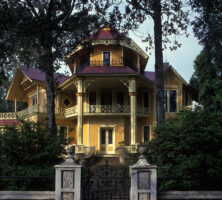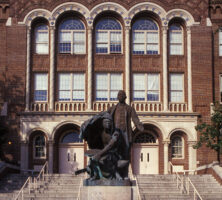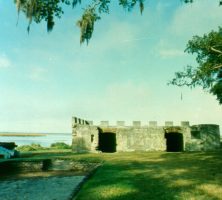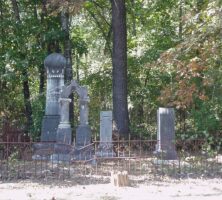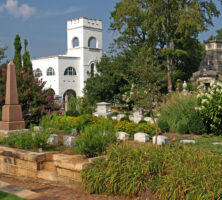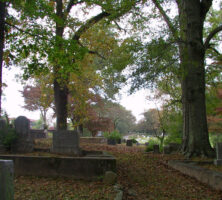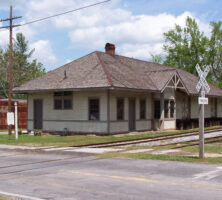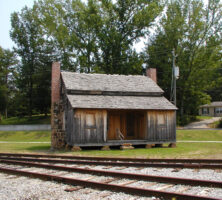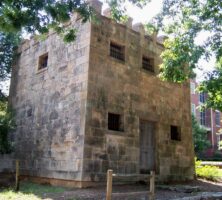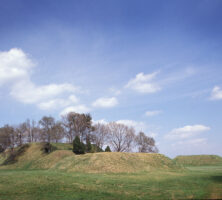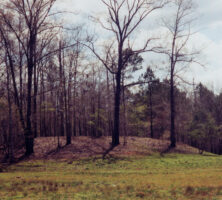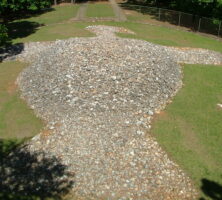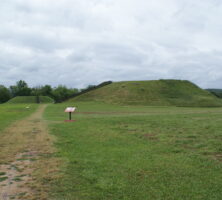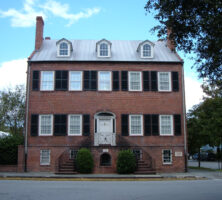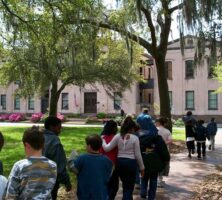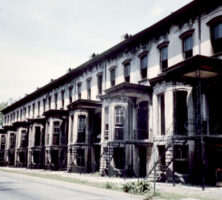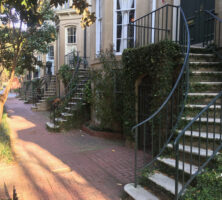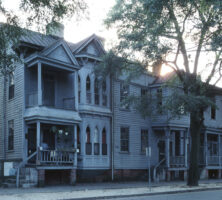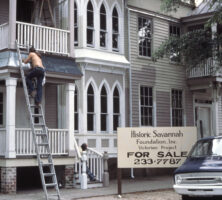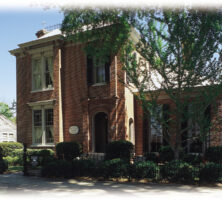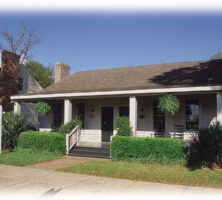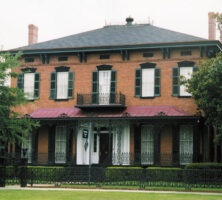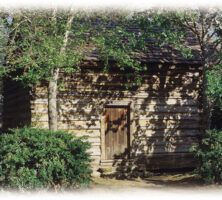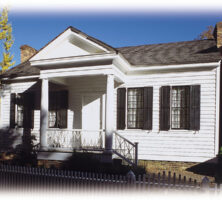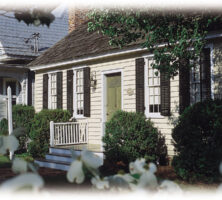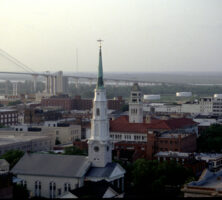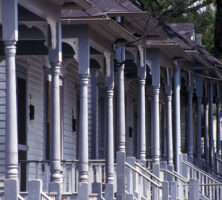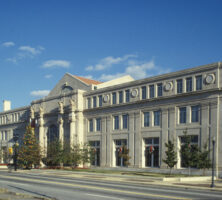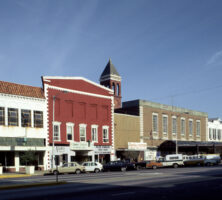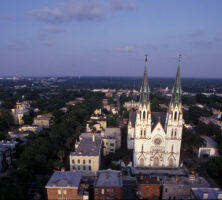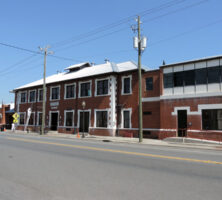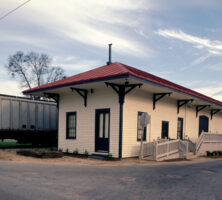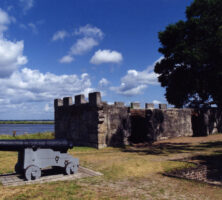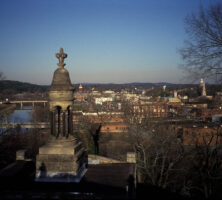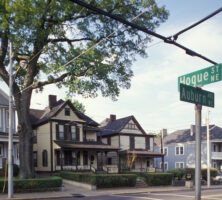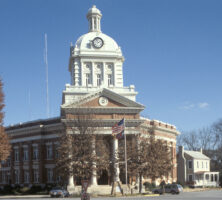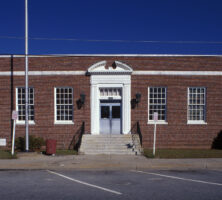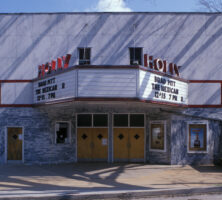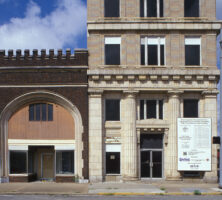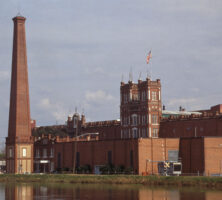The New Georgia Encyclopedia is supported by funding from A More Perfect Union, a special initiative of the National Endowment for the Humanities.
The New Georgia Encyclopedia does not hold the copyright for this media resource and can neither grant nor deny permission to republish or reproduce the image online or in print. All requests for permission to publish or reproduce the resource must be submitted to the rights holder.
The New Georgia Encyclopedia does not hold the copyright for this media resource and can neither grant nor deny permission to republish or reproduce the image online or in print. All requests for permission to publish or reproduce the resource must be submitted to the rights holder.
Founded in 1882 by the Gospel Pilgrim Society, the Gospel Pilgrim Cemetery in Athens, GA provided burial spaces for formerly enslaved individuals.
Image from Wikimedia
The New Georgia Encyclopedia does not hold the copyright for this media resource and can neither grant nor deny permission to republish or reproduce the image online or in print. All requests for permission to publish or reproduce the resource must be submitted to the rights holder.
Seashells and broken pottery, like these at Antioch Baptist Cemetery in Fayetteville, Georgia, were often used to decorate the graves of African American and formerly enslaved people.
Courtesy of Marlene Koslowsky
The New Georgia Encyclopedia does not hold the copyright for this media resource and can neither grant nor deny permission to republish or reproduce the image online or in print. All requests for permission to publish or reproduce the resource must be submitted to the rights holder.
Oakland Cemetery in Atlanta is the final resting place for 6,900 Confederate soliders, including 5 generals, as well as 16 Union soldiers.
Ren and Helen Davis
The New Georgia Encyclopedia does not hold the copyright for this media resource and can neither grant nor deny permission to republish or reproduce the image online or in print. All requests for permission to publish or reproduce the resource must be submitted to the rights holder.
Around 500 Confederate soldiers and 1 Union soldier are buried at the Stonewall Confederate Cemetery in Griffin.
Photograph by Melinda Smith Mullikin, New Georgia Encyclopedia
The New Georgia Encyclopedia does not hold the copyright for this media resource and can neither grant nor deny permission to republish or reproduce the image online or in print. All requests for permission to publish or reproduce the resource must be submitted to the rights holder.
The Confederate section of Linwood Cemetery in Columbus holds around 200 Confederate soldiers killed during the Civil War.
Courtesy of Historic Linwood Foundation, Inc.
The New Georgia Encyclopedia does not hold the copyright for this media resource and can neither grant nor deny permission to republish or reproduce the image online or in print. All requests for permission to publish or reproduce the resource must be submitted to the rights holder.
The Marietta National Cemetery is located at 500 Washington Avenue in Marietta. There are more than 10,000 Union soldiers buried here, with approximately 3,000 of them unknown. Confederate soldiers were interred at a separate Confederate cemetery in Marietta.
Image from Ron Zanoni
The New Georgia Encyclopedia does not hold the copyright for this media resource and can neither grant nor deny permission to republish or reproduce the image online or in print. All requests for permission to publish or reproduce the resource must be submitted to the rights holder.
Andersonville National Cemetery in Macon County holds approximately 13,000 Union soldiers who died while imprisoned at Andersonville Prison in 1864-65. It was designated a national cemetery in 1866 and is managed today by the National Park Service.
Image from Bubba73 (talk), Jud McCranie
The New Georgia Encyclopedia does not hold the copyright for this media resource and can neither grant nor deny permission to republish or reproduce the image online or in print. All requests for permission to publish or reproduce the resource must be submitted to the rights holder.
The Old Pickens County Jail in Jasper was built in 1906 and is listed on the National Register of Historic Places. Marble from the nearby Delaware Quarry was used for the front of the building. The jail, which contains a gallows that was never used, closed in 1980.
Image from Thomson M
The New Georgia Encyclopedia does not hold the copyright for this media resource and can neither grant nor deny permission to republish or reproduce the image online or in print. All requests for permission to publish or reproduce the resource must be submitted to the rights holder.
Sacred Fire, a twenty-five-foot sculpture of stainless steel and bronze, stands outside the Chattahoochee Indian Heritage Center in Fort Mitchell, Alabama. The heritage center is a project of the Historic Chattahoochee Commission, a joint preservation agency of Alabama and Georgia.
Courtesy of Historic Chattahoochee Commission
The New Georgia Encyclopedia does not hold the copyright for this media resource and can neither grant nor deny permission to republish or reproduce the image online or in print. All requests for permission to publish or reproduce the resource must be submitted to the rights holder.
Located nine miles southwest of Blakely, in Early County, the Coheelee Creek Covered Bridge is the southernmost covered bridge in the United States. It was built in 1891 and is listed on the National Register of Historic Places.
Courtesy of Georgia Department of Economic Development.
The New Georgia Encyclopedia does not hold the copyright for this media resource and can neither grant nor deny permission to republish or reproduce the image online or in print. Requests for permission to publish or reproduce the resource may need to be submitted to the Georgia Department of Economic Development.
The New Georgia Encyclopedia does not hold the copyright for this media resource and can neither grant nor deny permission to republish or reproduce the image online or in print. All requests for permission to publish or reproduce the resource must be submitted to the rights holder.
The Historic Chattahoochee Commission has published several educational titles, including A Chattahoochee Album (2000), by Fred C. Fussell.
The New Georgia Encyclopedia does not hold the copyright for this media resource and can neither grant nor deny permission to republish or reproduce the image online or in print. All requests for permission to publish or reproduce the resource must be submitted to the rights holder.
This blank "planetary photographic record" was published around 1869 and functioned as a family tree. The keeping of records and the tracing of ancestral lineage was primarily done in earlier centuries to establish a family's nobility. Today these records form an integral part of the historical record.
Courtesy of Library of Congress, Prints and Photographs Division
The New Georgia Encyclopedia does not hold the copyright for this media resource and can neither grant nor deny permission to republish or reproduce the image online or in print. All requests for permission to publish or reproduce the resource must be submitted to the rights holder.
The Georgia Historical Society, housed in Hodgson Hall in Savannah, holds one of the largest collections of genealogical records in the state.
Courtesy of Georgia Historical Society.
The New Georgia Encyclopedia does not hold the copyright for this media resource and can neither grant nor deny permission to republish or reproduce the image online or in print. All requests for permission to publish or reproduce the resource must be submitted to Georgia Historical Society.
This family record chart was marketed to African American families during the 1880s. Because detailed family records were not typically kept for enslaved people prior to the Civil War, conducting genealogical research has often posed a challenge for Black families. This difficulty is depicted by the chart's pictorial representations of life before and after the war.
Courtesy of Library of Congress, Prints and Photographs Division
The New Georgia Encyclopedia does not hold the copyright for this media resource and can neither grant nor deny permission to republish or reproduce the image online or in print. All requests for permission to publish or reproduce the resource must be submitted to the rights holder.
The cemetery at Midway Church in Liberty County was established soon after the first church building was completed in 1756. Georgia's Cemetery and Burial Ground Policy Act of 1991 protects such cemeteries, which are defined as an irreplaceable part of the state's cultural heritage.
Courtesy of Georgia Historical Society.
The New Georgia Encyclopedia does not hold the copyright for this media resource and can neither grant nor deny permission to republish or reproduce the image online or in print. All requests for permission to publish or reproduce the resource must be submitted to Georgia Historical Society.
The historic Couey House in Summerville, built during the 1840s, was one of the first pioneer homes in Chattooga County. Moved about seven miles from its original location to accomodate the widening of U.S. Highway 27 in 1995, the house is today owned and preserved by the Georgia Department of Transportation.
Photograph by Shelia J. Cothran, City of Summerville
The New Georgia Encyclopedia does not hold the copyright for this media resource and can neither grant nor deny permission to republish or reproduce the image online or in print. All requests for permission to publish or reproduce the resource must be submitted to the rights holder.
In 1804 the prominent Cherokee leader James Vann built his home in Murray County. The original home has been restored and is known today as the Chief Vann House Historic Site.
Image from Thomson200
The New Georgia Encyclopedia does not hold the copyright for this media resource and can neither grant nor deny permission to republish or reproduce the image online or in print. All requests for permission to publish or reproduce the resource must be submitted to the rights holder.
The Camilla-Zach Country Life Center is part of the Camilla-Zach Community Center Historic District, which was added to the National Register of Historic Places in 1974. Located in Hancock County, the center was established in 1932 by Benjamin Hubert, the founder of the Association for the Advancement of Negro Country Life.
Courtesy of GAAHPN
The New Georgia Encyclopedia does not hold the copyright for this media resource and can neither grant nor deny permission to republish or reproduce the image online or in print. All requests for permission to publish or reproduce the resource must be submitted to the rights holder.
This drawing of a shotgun house serves as the logo for the Georgia African American Historic Preservation Network. This network of volunteers, which is dedicated to preserving historic sites related to Georgia's African American heritage, began in 1982.
Courtesy of GAAHPN
The New Georgia Encyclopedia does not hold the copyright for this media resource and can neither grant nor deny permission to republish or reproduce the image online or in print. All requests for permission to publish or reproduce the resource must be submitted to the rights holder.
The New Georgia Encyclopedia does not hold the copyright for this media resource and can neither grant nor deny permission to republish or reproduce the image online or in print. All requests for permission to publish or reproduce the resource must be submitted to the rights holder.
The St. John United Methodist Church building in Augusta was built in 1844 and expanded during the 1890s. The church was restored to its nineteenth-century appearance in 1998, and in 2001 it hosted the Southeast Regional African American Historic Preservation Alliance conference.
Courtesy of GAAHPN
The New Georgia Encyclopedia does not hold the copyright for this media resource and can neither grant nor deny permission to republish or reproduce the image online or in print. All requests for permission to publish or reproduce the resource must be submitted to the rights holder.
The participants, trainers, and staff of "Your Town: Citizens' Institute on Rural Design" gather for a photograph with U.S. president Jimmy Carter on the steps of Plains High School in 2002. "Your Town," sponsored by the National Trust for Historic Preservation, has offered workshops for rural preservationists in cities around the country since 1991.
Courtesy of GAAHPN
The New Georgia Encyclopedia does not hold the copyright for this media resource and can neither grant nor deny permission to republish or reproduce the image online or in print. All requests for permission to publish or reproduce the resource must be submitted to the rights holder.
The "Tower of Aspiration," sculpted by Chicago artist Richard Hunt, stands in downtown Augusta's Springfield Village Park. The park is also home to the historic Springfield Baptist Church, visible in the background, which was constructed in 1897 and is home to the oldest African American congregation in the country.
Courtesy of GAAHPN
The New Georgia Encyclopedia does not hold the copyright for this media resource and can neither grant nor deny permission to republish or reproduce the image online or in print. All requests for permission to publish or reproduce the resource must be submitted to the rights holder.
Volunteers excavate near slave quarters on Ossabaw Island, a mostly uninhabited barrier island that is ideal for archaeological digs because of its pristine condition. Ossabaw Island became the property of the state of Georgia in 1978.
The New Georgia Encyclopedia does not hold the copyright for this media resource and can neither grant nor deny permission to republish or reproduce the image online or in print. Requests for permission to publish or reproduce the resource may need to be submitted to the Georgia Department of Community Affairs, Historic Preservation Division.
The Cartersville Historic Preservation Commission was created to ensure that alterations of designated historic properties in the city maintain the character of both the building and its surrounding neighborhood.
Photograph by Jennifer Martin Lewis
The New Georgia Encyclopedia does not hold the copyright for this media resource and can neither grant nor deny permission to republish or reproduce the image online or in print. All requests for permission to publish or reproduce the resource must be submitted to the rights holder.
Excavations of old homes frequently uncover archaeological deposits under the floors and in the yard areas. Members of local government historic preservation commissions work to locate and catalog these deposits.
The New Georgia Encyclopedia does not hold the copyright for this media resource and can neither grant nor deny permission to republish or reproduce the image online or in print. Requests for permission to publish or reproduce the resource may need to be submitted to the Georgia Department of Community Affairs, Historic Preservation Division.
Careful measurement and record keeping is critical to archaeological investigation. Historic preservation commission members use a theodolite (surveyor's scope) to measure land gradient.
The New Georgia Encyclopedia does not hold the copyright for this media resource and can neither grant nor deny permission to republish or reproduce the image online or in print. Requests for permission to publish or reproduce the resource may need to be submitted to the Georgia Department of Community Affairs, Historic Preservation Division.
The Lapham-Patterson House in Thomasville was built in 1884-85 as a winter home for the Chicago shoe merchant C. W. Lapham. A Victorian-style home with many unusual architectural characteristics, including a double-flue chimney with a walk-through stairway, the house was designated a National Historic Landmark in 1975.
The New Georgia Encyclopedia does not hold the copyright for this media resource and can neither grant nor deny permission to republish or reproduce the image online or in print. Requests for permission to publish or reproduce the resource may need to be submitted to the Georgia Department of Community Affairs, Historic Preservation Division.
Opened in 1924, Booker T. Washington High School was the first high school for African American students in Atlanta. Placed on the National Register of Historic Places in 1986, the school boasts such notable graduates as Lena Horne and Martin Luther King Jr. Renovations on the school began in 2004.
The New Georgia Encyclopedia does not hold the copyright for this media resource and can neither grant nor deny permission to republish or reproduce the image online or in print. Requests for permission to publish or reproduce the resource may need to be submitted to the Georgia Department of Community Affairs, Historic Preservation Division.
Georgia's Department of Natural Resources and the National Park Service join forces to offer an archaeological training program for teachers each summer at Fort Frederica National Monument on St. Simons Island. Students later return with their teachers to excavate a simulated colonial site.
Courtesy of Sea Island Company
The New Georgia Encyclopedia does not hold the copyright for this media resource and can neither grant nor deny permission to republish or reproduce the image online or in print. All requests for permission to publish or reproduce the resource must be submitted to the rights holder.
The New Georgia Encyclopedia does not hold the copyright for this media resource and can neither grant nor deny permission to republish or reproduce the image online or in print. All requests for permission to publish or reproduce the resource must be submitted to the rights holder.
Small family cemeteries are found throughout Georgia. Generally the maintenance of such cemeteries falls to family and local community members.
The New Georgia Encyclopedia does not hold the copyright for this media resource and can neither grant nor deny permission to republish or reproduce the image online or in print. Requests for permission to publish or reproduce the resource may need to be submitted to the Georgia Department of Community Affairs, Historic Preservation Division.
The New Georgia Encyclopedia does not hold the copyright for this media resource and can neither grant nor deny permission to republish or reproduce the image online or in print. All requests for permission to publish or reproduce the resource must be submitted to the rights holder.
The New Georgia Encyclopedia does not hold the copyright for this media resource and can neither grant nor deny permission to republish or reproduce the image online or in print. All requests for permission to publish or reproduce the resource must be submitted to the rights holder.
Established in 1850, Oakland Cemetery in Atlanta is one of three urban historic cemeteries in Georgia to be managed by nonprofit organizations. Oakland was placed on the National Register of Historic Places in 1976, and the Historic Oakland Foundation was founded that same year.
Courtesy of Ren and Helen Davis
The New Georgia Encyclopedia does not hold the copyright for this media resource and can neither grant nor deny permission to republish or reproduce the image online or in print. All requests for permission to publish or reproduce the resource must be submitted to the rights holder.
Decatur Cemetery, established during the nineteenth century, was listed on the National Register of Historic Places in 1997 and is preserved by an organization called the Friends of Decatur Cemetery. A 7.5-acre area known as the "Old Cemetery" includes historic African American burial sites.
Photograph by Melinda G. Smith, New Georgia Encyclopedia
The New Georgia Encyclopedia does not hold the copyright for this media resource and can neither grant nor deny permission to republish or reproduce the image online or in print. All requests for permission to publish or reproduce the resource must be submitted to the rights holder.
The Chattanooga, Rome, and Columbus Railroad reached Chattooga County in 1889, with lines to Summerville, Lyerly, and Trion. The original depot was built the same year. In 1901 the CR&C merged with the Central of Georgia. The depot, pictured in 2004, was placed on the National Register of Historic Places in 1992.
Photograph by Shelia J. Cothran, City of Summerville
The New Georgia Encyclopedia does not hold the copyright for this media resource and can neither grant nor deny permission to republish or reproduce the image online or in print. All requests for permission to publish or reproduce the resource must be submitted to the rights holder.
Built in the early 1840s by Andrew McSelland Couey and his sons, this single-pen log house is one of the earliest pioneer homes in Chattooga County. Because the original site in Tidings was needed for the widening of U.S. Highway 27, the house was moved in 1995 to Dowdy Park in Summerville.
Photograph by Shelia J. Cothran, City of Summerville
The New Georgia Encyclopedia does not hold the copyright for this media resource and can neither grant nor deny permission to republish or reproduce the image online or in print. All requests for permission to publish or reproduce the resource must be submitted to the rights holder.
Brasstown Bald, the highest mountain in Georgia, offers a panoramic view of four states. The Bald is located along the Russell-Brasstown byway, one of the corridors designated as a Georgia Scenic Byway by the Georgia Department of Transportation.
Image from Tim Corradino
The New Georgia Encyclopedia does not hold the copyright for this media resource and can neither grant nor deny permission to republish or reproduce the image online or in print. All requests for permission to publish or reproduce the resource must be submitted to the rights holder.
The Department of Transportation established the Scenic Byways program to protect or enhance the character and appeal of designated roads. The Monticello Crossroads in Jasper County is one of seven such corridors in the state.
Courtesy of Georgia Department of Economic Development.
The New Georgia Encyclopedia does not hold the copyright for this media resource and can neither grant nor deny permission to republish or reproduce the image online or in print. Requests for permission to publish or reproduce the resource may need to be submitted to the Georgia Department of Economic Development.
The Greensboro Gaol (1807), one of the oldest penal structures in Georgia, was a historic preservation project of North Georgia Regional Preservation Services.
Photograph by J. Stephen Conn
The New Georgia Encyclopedia does not hold the copyright for this media resource and can neither grant nor deny permission to republish or reproduce the image online or in print. All requests for permission to publish or reproduce the resource must be submitted to the rights holder.
The New Georgia Encyclopedia does not hold the copyright for this media resource and can neither grant nor deny permission to republish or reproduce the image online or in print. All requests for permission to publish or reproduce the resource must be submitted to the rights holder.
The Etowah Mounds in Bartow County include one of the largest Indian mounds in North America. The mounds, constructed during the Mississippian Period, served as platforms for public buildings in a town that occupied the site from around 1100 until the 1600s.
The New Georgia Encyclopedia does not hold the copyright for this media resource and can neither grant nor deny permission to republish or reproduce the image online or in print. Requests for permission to publish or reproduce the resource may need to be submitted to the Georgia Department of Community Affairs, Historic Preservation Division.
The excavation of the Singer-Moye Mounds in Stewart County has revealed the buried foundations of Indian buildings that were destroyed and abandoned more than 600 years ago. Thousands of ceramics fragments and animal bones have also been recovered.
Photograph by Elisabeth Hughes, New Georgia Encyclopedia
The New Georgia Encyclopedia does not hold the copyright for this media resource and can neither grant nor deny permission to republish or reproduce the image online or in print. All requests for permission to publish or reproduce the resource must be submitted to the rights holder.
Located north of Eatonton in Putnam County, Rock Eagle is an Indian-made rock structure dating back to the Middle Woodland period (300 B.C. to A.D. 600).
Photograph by Brian McInturff
The New Georgia Encyclopedia does not hold the copyright for this media resource and can neither grant nor deny permission to republish or reproduce the image online or in print. All requests for permission to publish or reproduce the resource must be submitted to the rights holder.
A path leading to two of the mounds at the Etowah Indian Mounds Historic Site. Located in Bartow County, the site is home to the second-largest Indian mound in North America, rises to a height of slightly more than 60 feet.
Photograph from Sharon Meier
The New Georgia Encyclopedia does not hold the copyright for this media resource and can neither grant nor deny permission to republish or reproduce the image online or in print. All requests for permission to publish or reproduce the resource must be submitted to the rights holder.
The Federal-style Davenport House (1821) was saved from demolition in 1955 by a group of women in Savannah. The presevation of this house launched the Historic Savannah Foundation.
Courtesy of Historic Savannah Foundation
The New Georgia Encyclopedia does not hold the copyright for this media resource and can neither grant nor deny permission to republish or reproduce the image online or in print. All requests for permission to publish or reproduce the resource must be submitted to the rights holder.
The New Georgia Encyclopedia does not hold the copyright for this media resource and can neither grant nor deny permission to republish or reproduce the image online or in print. All requests for permission to publish or reproduce the resource must be submitted to the rights holder.
Many Savannahians dress in colonial costume for the annual Georgia Day (February 12) festivities. Many activities are designed to educate children about the area's cultural heritage.
Courtesy of Historic Savannah Foundation
The New Georgia Encyclopedia does not hold the copyright for this media resource and can neither grant nor deny permission to republish or reproduce the image online or in print. All requests for permission to publish or reproduce the resource must be submitted to the rights holder.
The Massie Heritage Center, founded in 1975, houses one of the country's first heritage education programs. The center offers information about the historic environment of Savannah to both students and teachers.
Courtesy of Massie Heritage Center
The New Georgia Encyclopedia does not hold the copyright for this media resource and can neither grant nor deny permission to republish or reproduce the image online or in print. All requests for permission to publish or reproduce the resource must be submitted to the rights holder.
The New Georgia Encyclopedia does not hold the copyright for this media resource and can neither grant nor deny permission to republish or reproduce the image online or in print. All requests for permission to publish or reproduce the resource must be submitted to the rights holder.
These rowhouses near Troup Square are pictured in the 1960s, before the Historic Savannah Foundation preserved them.
Courtesy of Historic Savannah Foundation
The New Georgia Encyclopedia does not hold the copyright for this media resource and can neither grant nor deny permission to republish or reproduce the image online or in print. All requests for permission to publish or reproduce the resource must be submitted to the rights holder.
The historic rowhouses near Troup Square have been preserved and renovated as one of the Historic Savannah Foundation's projects.
Photograph by Seasider53
The New Georgia Encyclopedia does not hold the copyright for this media resource and can neither grant nor deny permission to republish or reproduce the image online or in print. All requests for permission to publish or reproduce the resource must be submitted to the rights holder.
This historic building on West Duffy Street is pictured in 1979, before the Historic Savannah Foundation rescued and restored the structure.
Courtesy of Historic Savannah Foundation
The New Georgia Encyclopedia does not hold the copyright for this media resource and can neither grant nor deny permission to republish or reproduce the image online or in print. All requests for permission to publish or reproduce the resource must be submitted to the rights holder.
A restoration project on West Duffy Street overseen by the Historic Savannah Foundation, 1982.
Courtesy of Historic Savannah Foundation
The New Georgia Encyclopedia does not hold the copyright for this media resource and can neither grant nor deny permission to republish or reproduce the image online or in print. All requests for permission to publish or reproduce the resource must be submitted to the rights holder.
The restored Italian villa-style house known as 700 Broadway was the only two-story brick home in the original city of Columbus. The structure dates to the 1830s.
Courtesy of Historic Columbus Foundation
The New Georgia Encyclopedia does not hold the copyright for this media resource and can neither grant nor deny permission to republish or reproduce the image online or in print. All requests for permission to publish or reproduce the resource must be submitted to the rights holder.
The Historic Columbus Foundation office is located at 708 Broadway, in what is still known as the Woodruff Farm House. The double-pen structure dates to the 1840s and was moved to Broadway in the 1980s.
Courtesy of Historic Columbus Foundation
The New Georgia Encyclopedia does not hold the copyright for this media resource and can neither grant nor deny permission to republish or reproduce the image online or in print. All requests for permission to publish or reproduce the resource must be submitted to the rights holder.
The Rankin House at 1440 Second Avenue was built for James Rankin, a planter and the owner of the Rankin Hotel and the Rankin Realty Company. The restored house, ca. 1850-70, is now a museum.
Courtesy of Historic Columbus Foundation
The New Georgia Encyclopedia does not hold the copyright for this media resource and can neither grant nor deny permission to republish or reproduce the image online or in print. All requests for permission to publish or reproduce the resource must be submitted to the rights holder.
Heritage Park is designed to recognize the people who harnessed the river and created the industries that laid the foundations for modern Columbus. Outdoor sculptures and historic elements of the park represent the textile, gristmill, brick, and foundry industries involved in the growth and development of the area.
Courtesy of Historic Columbus Foundation
The New Georgia Encyclopedia does not hold the copyright for this media resource and can neither grant nor deny permission to republish or reproduce the image online or in print. All requests for permission to publish or reproduce the resource must be submitted to the rights holder.
Moved from its original location ten miles from the current site, this structure is an example of a log cabin used by traders in the early 1800s prior to the settlement of Columbus.
Courtesy of Historic Columbus Foundation
The New Georgia Encyclopedia does not hold the copyright for this media resource and can neither grant nor deny permission to republish or reproduce the image online or in print. All requests for permission to publish or reproduce the resource must be submitted to the rights holder.
This Greek revival-style cottage, at 11 Seventh Street in Columbus, was occupied by John Stith Pemberton and his family, 1855-60. Pemberton, a druggist in Columbus and later Atlanta, was the originator of Coca-Cola. The apothecary, once the kitchen, houses unique Coke memorabilia.
Courtesy of Historic Columbus Foundation
The New Georgia Encyclopedia does not hold the copyright for this media resource and can neither grant nor deny permission to republish or reproduce the image online or in print. All requests for permission to publish or reproduce the resource must be submitted to the rights holder.
The Walker-Peters-Langdon house, a simple Federal cottage located at 716 Broadway, was built in 1828 and is considered the oldest house in Columbus. The grounds include a slave cabin and other outbuildings.
Courtesy of Historic Columbus Foundation
The New Georgia Encyclopedia does not hold the copyright for this media resource and can neither grant nor deny permission to republish or reproduce the image online or in print. All requests for permission to publish or reproduce the resource must be submitted to the rights holder.
A modern tourboat passes the Confederate Powder Works chimney in Augusta along the Augusta Canal. The Georgia Community Greenspace Program has worked to preserve the Augusta Canal as an important historic and archaeological site.
Courtesy of Explore Georgia, Photograph by Ralph Daniel.
The New Georgia Encyclopedia does not hold the copyright for this media resource and can neither grant nor deny permission to republish or reproduce the image online or in print. Requests for permission to publish or reproduce the resource may need to be submitted to Explore Georgia.
The Georgia Historical Commission gained national recognition as a pioneer in state historic preservation. The commission erected some 1,800 historical markers. This marker designates the site of the Cedar Creek Primitive Baptist Church, established in 1813 in Tattnall County.
Courtesy of Georgia Info, Digital Library of Georgia.
The New Georgia Encyclopedia does not hold the copyright for this media resource and can neither grant nor deny permission to republish or reproduce the image online or in print. Requests for permission to publish or reproduce the resource may need to be submitted to the Digital Library of Georgia.
Savannah, the first city in Georgia settled by colonists in 1733, was also one of the first cities in the state to begin a historic preservation program.
The New Georgia Encyclopedia does not hold the copyright for this media resource and can neither grant nor deny permission to republish or reproduce the image online or in print. Requests for permission to publish or reproduce the resource may need to be submitted to the Georgia Department of Community Affairs, Historic Preservation Division.
A strong African American cultural presence throughout the nineteenth and twentieth centuries has left an extensive imprint, which is especially visible in the Martin Luther King Jr. and Sweet Auburn areas of Atlanta.
The New Georgia Encyclopedia does not hold the copyright for this media resource and can neither grant nor deny permission to republish or reproduce the image online or in print. Requests for permission to publish or reproduce the resource may need to be submitted to the Georgia Department of Community Affairs, Historic Preservation Division.
In 1992 Congress passed a transportation bill that provided enhancement funding for historic and natural resources associated with transportation routes and facilities, such as Macon's railroad depot.
The New Georgia Encyclopedia does not hold the copyright for this media resource and can neither grant nor deny permission to republish or reproduce the image online or in print. Requests for permission to publish or reproduce the resource may need to be submitted to the Georgia Department of Community Affairs, Historic Preservation Division.
Federal tax credits were particularly important in stimulating major commercial area projects in smaller cities like Rome, whose downtown programs have won national awards.
The New Georgia Encyclopedia does not hold the copyright for this media resource and can neither grant nor deny permission to republish or reproduce the image online or in print. Requests for permission to publish or reproduce the resource may need to be submitted to the Georgia Department of Community Affairs, Historic Preservation Division.
Downtown Macon still retains most of its original historic buildings, which have been preserved and revitalized as its residents take an interest in their city's past.
The New Georgia Encyclopedia does not hold the copyright for this media resource and can neither grant nor deny permission to republish or reproduce the image online or in print. Requests for permission to publish or reproduce the resource may need to be submitted to the Georgia Department of Community Affairs, Historic Preservation Division.
After the Columbus historic district was surveyed and listed in the National Register of Historic Places in 1969, the new Historic Columbus Foundation worked to attract residents back to the downtown residential area.
The New Georgia Encyclopedia does not hold the copyright for this media resource and can neither grant nor deny permission to republish or reproduce the image online or in print. Requests for permission to publish or reproduce the resource may need to be submitted to the Georgia Department of Community Affairs, Historic Preservation Division.
The restored Cathedral of St. John the Baptist is in the heart of Savannah's historic district. In the almost fifty years since the Historic Savannah Foundation began reclaiming the city's historic downtown neighborhoods, historic preservation has increasingly been used in Georgia as the basis for community development.
The New Georgia Encyclopedia does not hold the copyright for this media resource and can neither grant nor deny permission to republish or reproduce the image online or in print. Requests for permission to publish or reproduce the resource may need to be submitted to the Georgia Department of Community Affairs, Historic Preservation Division.
Local leaders named the city of Waycross after the many roads crossing here in 1874. The area was once known as Old Nine, or Number Nine, after the railroad station number.
Photograph by J. Stephen Conn
The New Georgia Encyclopedia does not hold the copyright for this media resource and can neither grant nor deny permission to republish or reproduce the image online or in print. All requests for permission to publish or reproduce the resource must be submitted to the rights holder.
The Byron depot has been restored and now serves as a museum housing photographs and other memorabilia of the city's history.
The New Georgia Encyclopedia does not hold the copyright for this media resource and can neither grant nor deny permission to republish or reproduce the image online or in print. Requests for permission to publish or reproduce the resource may need to be submitted to the Georgia Department of Community Affairs, Historic Preservation Division.
The British regiment at Frederica disbanded in May 1749. In April 1758, a great fire swept Frederica, reducing much of it to ashes. Today the ruins form the Fort Frederica National Monument.
The New Georgia Encyclopedia does not hold the copyright for this media resource and can neither grant nor deny permission to republish or reproduce the image online or in print. All requests for permission to publish or reproduce the resource must be submitted to the rights holder.
The New Georgia Encyclopedia does not hold the copyright for this media resource and can neither grant nor deny permission to republish or reproduce the image online or in print. All requests for permission to publish or reproduce the resource must be submitted to the rights holder.
The New Georgia Encyclopedia does not hold the copyright for this media resource and can neither grant nor deny permission to republish or reproduce the image online or in print. All requests for permission to publish or reproduce the resource must be submitted to the rights holder.
The New Georgia Encyclopedia does not hold the copyright for this media resource and can neither grant nor deny permission to republish or reproduce the image online or in print. All requests for permission to publish or reproduce the resource must be submitted to the rights holder.
The New Georgia Encyclopedia does not hold the copyright for this media resource and can neither grant nor deny permission to republish or reproduce the image online or in print. All requests for permission to publish or reproduce the resource must be submitted to the rights holder.
The results of more self-conscious community-oriented interest can be seen in communities large and small, across the state, from Savannah to Flowery Branch, Valdosta to Rome. This is a view of Rome from the city's Myrtle Hill Cemetery.
The New Georgia Encyclopedia does not hold the copyright for this media resource and can neither grant nor deny permission to republish or reproduce the image online or in print. Requests for permission to publish or reproduce the resource may need to be submitted to the Georgia Department of Community Affairs, Historic Preservation Division.
In the Atlanta neighborhood where Martin Luther King Jr. grew up and later preached, the Historic District Development Corporation has been a leader in creating affordable housing and mixed-income development.
The New Georgia Encyclopedia does not hold the copyright for this media resource and can neither grant nor deny permission to republish or reproduce the image online or in print. Requests for permission to publish or reproduce the resource may need to be submitted to the Georgia Department of Community Affairs, Historic Preservation Division.
The New Georgia Encyclopedia does not hold the copyright for this media resource and can neither grant nor deny permission to republish or reproduce the image online or in print. All requests for permission to publish or reproduce the resource must be submitted to the rights holder.
The first courthouse in Morgan County was a red brick square building, built in 1809 on the square in the middle of downtown Madison. This building was converted to office space when the current courthouse was built across the street on the corner facing the square. In 1917, the original courthouse building was destroyed in a fire.
The New Georgia Encyclopedia does not hold the copyright for this media resource and can neither grant nor deny permission to republish or reproduce the image online or in print. Requests for permission to publish or reproduce the resource may need to be submitted to the Georgia Department of Community Affairs, Historic Preservation Division.
The New Georgia Encyclopedia does not hold the copyright for this media resource and can neither grant nor deny permission to republish or reproduce the image online or in print. All requests for permission to publish or reproduce the resource must be submitted to the rights holder.
The Baxley Post Office was one of the historic buildings preserved by the Main Street Renovation program.
The New Georgia Encyclopedia does not hold the copyright for this media resource and can neither grant nor deny permission to republish or reproduce the image online or in print. Requests for permission to publish or reproduce the resource may need to be submitted to the Georgia Department of Community Affairs, Historic Preservation Division.
Atlanta's Fox Theatre has seen more than $20 million in restoration projects since coming under the ownership of the nonprofit organization, Atlanta Landmarks, in 1975. The Fox was designated a National Historic Landmark in 1976.
The New Georgia Encyclopedia does not hold the copyright for this media resource and can neither grant nor deny permission to republish or reproduce the image online or in print. Requests for permission to publish or reproduce the resource may need to be submitted to the Georgia Department of Community Affairs, Historic Preservation Division.
The Holly Theater in Dahlonega was built in 1947 by Randall Holly Brannon. The theater was closed in the 1970s and eventually purchased by private citizens in 1992. The renovated theater reopened as a community theater in 1994.
The New Georgia Encyclopedia does not hold the copyright for this media resource and can neither grant nor deny permission to republish or reproduce the image online or in print. Requests for permission to publish or reproduce the resource may need to be submitted to the Georgia Department of Community Affairs, Historic Preservation Division.
In 2003 Greensboro was a Main Street Community of the Georgia Department of Community Affairs.
The New Georgia Encyclopedia does not hold the copyright for this media resource and can neither grant nor deny permission to republish or reproduce the image online or in print. Requests for permission to publish or reproduce the resource may need to be submitted to the Georgia Department of Community Affairs, Historic Preservation Division.
Dublin was a Main Street Community of the Georgia Department of Community Affairs in 2003.
The New Georgia Encyclopedia does not hold the copyright for this media resource and can neither grant nor deny permission to republish or reproduce the image online or in print. Requests for permission to publish or reproduce the resource may need to be submitted to the Georgia Department of Community Affairs, Historic Preservation Division.
Because of the rail connections and convenient waterpower, Colonel George W. Rains constructed the Confederate Powder Works in Augusta. The tall chimney of the Powder Works still stands as a memorial to the Confederate dead.
The New Georgia Encyclopedia does not hold the copyright for this media resource and can neither grant nor deny permission to republish or reproduce the image online or in print. Requests for permission to publish or reproduce the resource may need to be submitted to the Georgia Department of Community Affairs, Historic Preservation Division.
